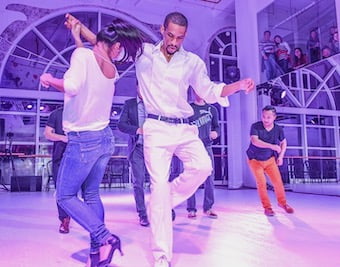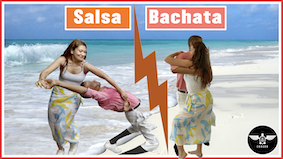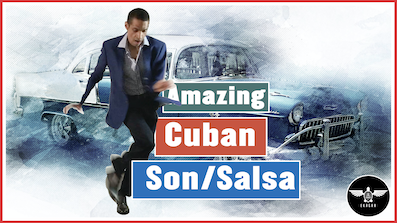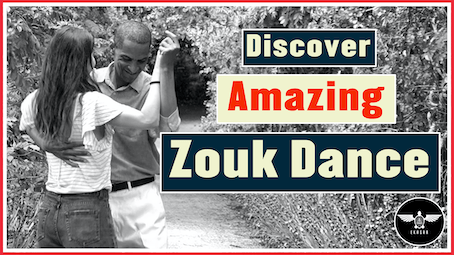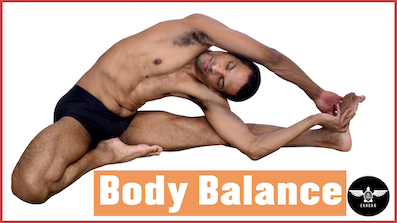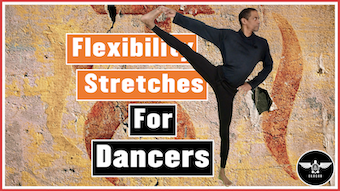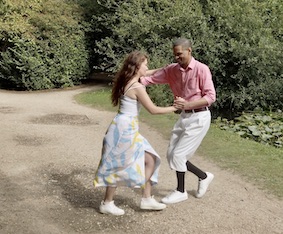
Salsa dancing is a dance genre created in the US in the mid-twentieth century. However, its ancestors trace their roots back to the popular dances of Cuba at the beginning of that epoch, with dances such as Son, Danzon, chachacha, or mambo. Although in Cuba, casino is the dance form closer to salsa, the genre took shape in the United States.
1. Where did Salsa dancing come from?
Salsa dancing took the world by storm 60 years ago. It started with the mass migration to the united states of Cubans, Puerto Ricans, and habitants of other Latin American countries. These people brought with them their culture, food, and music. Groups such as Fania All-star reached stardom in the feat of the Latin music fever of the seventies, with musicians such as Cheo Feliciano, Pacheco, Hector Lavoe, or Celia Cruz. These groups gathered together the best Latin American music at the time.
In reality, salsa dancing has many roots. The one depicted above is more connected to NewYork-style salsa since that’s where these group members migrated to. However, casino dance (Cuban salsa dancing) has a strong root in Cuba and the different types of dance that compose Cuban dance.
2. The different types of salsa dancing
I will not go extensively over the different styles of salsa dancing so that I don’t vilify and glorify another. Indeed, the problem is that when people take sides for a favorite type of salsa dance, they tend to shut down the “others” ones. I believe that no matter what kind of salsa, dancers must be able to reach a common ground where they experience the music. Unfortunately, this is often not the case because people are addicted to schools of thought rather than dance. That said, I will touch base on the styles of salsa dancing you might encounter and hopefully help you choose what sounds more attractive.
3. New York style (salsa on 2)
If you read the New York Times, the whole universe of salsa originated in New York. Although this is a bit exaggerated, there are great reasons why even this newspaper would believe so. For one, New York became the hub of great Latin music expansion in the mid-20th century.
3.1. The musicians who broke the glass ceiling
When musicians from Latin America hit New York in the 60s and seventies, they brought with them all the sensuality and flavor of their music. Bands like Fania All stars became instant classics as they carried a wave of excitement and even some form of dangerously. Singers like Hector Lavoe, Eddie Pacheco, Cheo Feliciano, and Willie Colon just took over and created some of the biggest hits in Latin music history.
Equally talented dancers entered the scene to match such gifted musicians. Most significant of whom was Eddie Torres.
3.2. The dancers who followed-up
Dancers like Eddie Torres and his dance company helped popularise the New York style of salsa dancing. He brought to the studios what people did on the streets when they danced Latin music. The key emphasis of this style is the focus of the step to the music’s second beat. That’s why it is called dance on 2.
This dance style has evolved with time to be more sophisticated, and sometimes, an air of superiority emanates from dancers who learned salsa on 2.
In the modern age, dancers like Franky Martinez have integrated more Jazz into this dance. Still, unlike what the name of his dancing company implies, there is nothing Abakua about how he dances. Abakua is a very traditional form of dance in Cuba, while Franky Martinez is more of a Latin Funk dancer.
✅ Pros:
– Great aesthetic
– Good dance skills
– More finger to finger than hand to hand contact
– Less body to body contact
The last two points are cited as Pros, as in certain corners of the world the notion of private space is very important.
⛔️ Cons:
▪️ Not the best salsa dancing style to socialise:
With many people busy showing off, it might not be easy to socialize with NY salsa dancers. This observation should be taken in the context that all salsa dancing allows socialization. But compared to others, it differs from the type where social interaction happens the fastest.
▪️ You might meet advanced dancers unwilling to go down to your level
This is just based on my observation and does not apply to everyone. Because there is a big emphasis on styling, some dancers with a good level can snob others with a lesser one. In all honesty, I despise people who do that because they kill all the true essence of dance, which is about melting yourself (and your partner) with the notes.
4. Cuban salsa – The misnomer
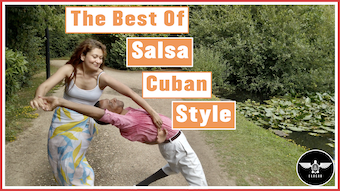
As the name suggests, it originated in Cuba at the beginning of the late century. It combines many other forms of dances like Son Cubano, fused with partner figures and turns adopted from the Cuban Mambo, Cuban Cha Cha Cha, and Rumba Guaguancó. It also has strong roots in Afro-Cuban dances such as Rumba, Abakua, Chango, etc. The reality is that Cuban salsa, known as casino, is not really salsa. It was categorized as such to make it marketable to outsiders and to fit into a category that resembled it the most. For sure, salsa (the North American dance) is deeply rooted in the different Cuban dances that shaped casino dance. The circular motion that characterizes Cuban salsa so much compared to the other forms of salsa is traceable back to Rueda dance (called casino Rueda, which is the original dance from Cuba and involves groups of couples dancing together).
4.1. The musicians
From the tradition of Son with groups such as Buena Vista Social Club, to elements of changui with Elito Reve, to recent features such as Mayito Rivera; the music is just as broad as the different dances that make up Cuban salsa dancing.
Music in Cuban salsa changes rhythms and pace often. Sometimes a break is accentuated, or a change of pace is pronounced. Other times, the song starts in a typical Latin way with brass instruments, etc., and changes radically to an African drum style of dance (check Mayito Rivera).
4.2. The dancers
Dancers such as Maykel Fonts and Yoannis Tamayo helped spread the message of Cuban salsa dancing abroad. I would compare Yoannis Tamayo to Romario or Maradona for anyone who loves football, while Maykel Fonts would be more of a Zidane. Both are great dancers; Yoannis Tamayo is more playful and spontaneous. They integrate dances such as Chango, Abakua, Rumba, Son, and Oggun into their way. As such, they are indeed the embodiment of what people call Cuban Salsa.
✅ Pros:
Very strong connection to the earth. As such many Cuban salsa dancers dance barefoot.
▪️ Very playful
The dance strongly engages males and females. It’s almost the equivalent of a “fight on the bed” where the male dancer tries to seduce the female dancer into accepting him. However, the female dancer is not intimidated and displays her own will. As a result, an entangling battle ensues for the pleasure of the senses. And the whole thing can be done without being sexual or inappropriate. That’s where the talent of the dancers resides.
▪️ Easy to socialise
The various types of dances that make-up Cuban salsa has a vital component of socialization ingrained into them. As a result, it is easy to approach salsa dancers of any level and enjoy a great time together.
▪️ Great work-out
With the frequent change in rhythm and pace, Cuban salsa dancing is a great workout. With moves that challenge your leg muscles, speed, and wit, you can get a great sweat with plenty of smiles.
⛔️ Cons:
▪️ Less focused on multiple spins and turns
Cuban salsa emphasizes more on body movements and less on multiple turns, so if that’s what you are after NYsalsa or LA salsa might be a better fit for you.
▪️ More hand to hand and body to body contact
I believe this is positive, but some might think it is not. The hand contacts help dancers improvise by using their partner’s body to execute their moves, such as falling on one leg before raising back up.
5. Other styles of salsa dancing include
5.1. L.A. salsa (Los Angeles)
The particularity of L.A. salsa dancing is that dancers focus on the first beat (as opposed to the second beat in New York). People have dubbed L.A. salsa to be more competition focused than, say, New York or Cuban styles. With the affluence of Congress worldwide, it is easy to understand why.
5.2. Cali salsa
There is also a Colombian style of salsa dancing that borrowed from the Caribbean rhythm. The style has quick steps. According to Wikipedia, Colombia has been dubbed the capital of salsa because of the country’s music genre’s popularity.
5.3. Miami style
This dance style is heavily influenced by the Cuban diaspora and many artists like Berna Jam. Dancers break mainly on 1, and the tempo can be very fast, aided by fast-moving feet and low motions of the upper body. This balance is difficult to achieve, but some Cuban dancers like Yoannis Tamayo or Ekagra-ji mix fast pace and body movements.
6. Is salsa dancing hard?
The answer to this question is, “It is one of the easiest languages you could learn; but it still is a language”. The difficulty also depends on the level of commitment of the student. For committed people, the level of proficiency will go higher, and so will the difficulty level. For the student who wants to have social fun, the level will be a bit lower. The only guarantee is that you will likely find something positive to take away from salsa.
Salsa dancing is most of the time associated with couple. From my own experience, I progressed the quickest when I practiced alone. Indeed, it is advisable to learn to dance by yourself and with a partner if you truly want to enjoy your experience. That said, some people are just in it for the girls, which is also fine. The best Salsa dancers have a vast repertoire of single-dance choreographies.
7. How do you dance salsa?
Let’s find out with this basic salsa video. You can also check the key singularities in steps between the different styles here.
8. I have more to offer
Learn Cuban Salsa, Bachata, Improv’ and many other dance styles. Check out these videos and see what you can achieve in less than 3 months. Private lessons available for just £35/Hour. Free body movement and basic salsa and bachata lessons provided.

